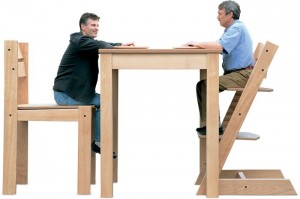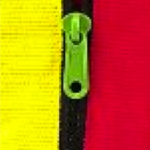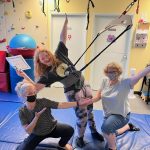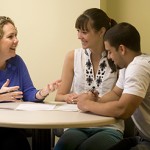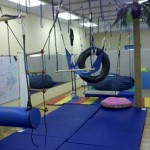
There are many reasons why a child will have difficulty sitting calmly in a chair. These are the most common problems I see that cause those wild wiggles!
1) The Chair Does Not Fit
Just like Goldilocks our children need a chair that is “just right”. The table or desk also need to be the correct height. Your child’s feet and back need to be supported. Have your child scoot back and see if if their back is supported and if the feet touch the ground. Just like us, children are not comfortable if their feet are dangling and they can’t lean back to rest. The correct table / desk height is even with your child’s elbow (with arms are down at their side). When the chair and desk do not fit children will get into all kinds of funny positions to try and get comfortable including: sitting on their leg, kneeling up in the chair, squatting in the chair or standing up. An easy fix for a chair that is too high is to add a foot rest. You can use old books duct taped together, a plastic box, or a short foot stool. If the seat is too deep you can add a pillow behind your child’s back. To keep it from slipping off the chair, hold it on with a T shirt or Sweatshirt over the pillow and back of the chair. This is an extremely common problem I see in schools and in the home at the dining table. A few small changes to make the chair and table or desk fit can make a world of difference for your child.
2) Poor Core Strength
Many children are not strong in their trunk which causes them to move a lot or slump and slide out of the chair. It takes more strength to be still than to move. You can screen your child’s core strength by seeing if he can lift up their arms and legs straight up off the floor while lying on their tummy and hold it for 20-30 seconds.
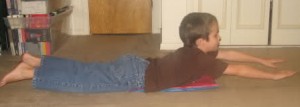
The check for abdominal strength see if he can hold a curled up position while lying on his back for 20-60 seconds (knees and head up off the floor while hugging his body – not hugging the legs).
If this is difficult for your child see an Occupational Therapist for an evaluation.
3) Expecting your Child to Sit for Too Long
With academic expectations increasing with younger and younger children we are seeing a rise in the expectations for young children to sit for longer than what is appropriate for their age (both at home and school). Young children (elementary age) need to get up and move frequently. Ideally, children would not sit for more than 15-20 minutes at a time. A simple break from sitting such as getting up and jumping 10x does wonders for waking up the body and mind. In general, children need to move as much as possible in order for their bodies and brains to develop properly
4) Problems with Body Awareness
Sitting calmly requires and strong sense of where the body is in space. Receptors in the muscles and joints called “proprioceptors” tell the brain about the body’s position. This allows us to operate our bodies without having to pay close attention and watch ourselves move. This is a very automatic process that is not automatic for many children who have Sensory Processing Disorder. When the body is moving, these proprioceptors are more active than when the body is still. Some children simply need to move to have a sense of where their body is. An Occupational Therapist who specializes in Sensory Processing Disorder aka Sensory Integration Dysfunction can evaluate your child to see if this is the case. She can also help this important sensation mature and give you activities to help your child at home.
5) Problems with Sense of Balance and Movement
Many children have a very poor sense of balance and movement. This important sensation is located in the inner ear and it is called the vestibular sense. It is basically our inner compass that tells the body what direction it is moving, how fast, if we are tipping over and how much the muscles need to be active to support the amount of movement. This sense also tells the muscles what to do in order to hold us still. When this sensation is under responsive, children will be constantly on the move literally “bouncing off the walls’ in order to feel balanced or they may just seem to “melt” and let gravity pull them to the ground. They will often slide or fall out of the chair and appear lethargic or sluggish. An Occupational Therapist who specializes in Sensory Processing Disorder aka Sensory Integration Dysfunction can evaluate your child to see if your child has problems with the vestibular sense. She can also help this important sensation mature and give you activities to help your child at home.
Mary Kostka is a Pediatric Occupational Therapist specializing in Sensory Processing Disorder at her private practice, ‘Ohana Occupational Therapy, LLC, in Wenatchee and Leavenworth Washington, USA
OhanaOt.com
‘Ohana Occupational Therapy, LLC
1139 N Princeton Suite B
Wenatchee, WA 98801
Ph: 509-888-7435
Fax: 509-888-7674
